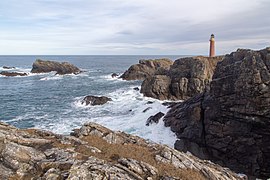Butt Of Lewis
The road to the lighthouse passes a sheltered cove called Port Stoth. Southwest from the lighthouse is a natural arch called the "Eye of the Butt" (Scottish Gaelic: Sùil an Rubha).
It is claimed that the Butt of Lewis is one of the windiest locations in the United Kingdom.
Lighthouse
The Butt of Lewis Lighthouse was built by the famous lighthouse builder David Stevenson in 1862. Other sources include Thomas Stevenson as one of the builders too. Little is known of the station's early history. A plaque in the lightroom indicates that the present equipment was installed in 1905. The station became the radio link for the keepers on the isolated Flannan Islands in the early 1930s, and continued to function as such until 1971, when the Flannans was made automatic.
The light was most-likely fuelled by fish oil in the beginning. This was then replaced by a paraffin burner in 1869 and finally by electricity in 1976.
It was operated by three Keepers who lived at the Station with their families but the fog signal was discontinued on 31 March 1995 and the light was automated on 30 March 1998. It is now remotely monitored from Edinburgh.
Until the early 1960s, all supplies were delivered by sea because of the poor road system on the island. This would occur at the nearby Port Stoth, where small cargo vessels would regularly berth if the weather allowed it to offload provisions for the lighthouse station.
The Butt of Lewis was also one the General Lighthouse Authorities transmitting stations for Differential GPS until March 2022.
Eilean nan Luchruban
One kilometre south-west of the Butt is a stack, or small island, of Eilean nan Luchruban, also known as the Pygmies' Isle. The isle was first mentioned by Dean Munro in about 1549 and described as being a ‘kirk’ where pygmies were buried. There are several structures on the island and earlier historical records mention bones in the structures. It was excavated by antiquarians sometime before 1905, when bones and pottery were found. The bones were found to be from animals and the pottery was later found to be from the Neolithic period.
RCAHMS surveyed the isle in 1928 and found part of the structures had collapsed since the excavations. A survey in 2005 found some additional structures not mentioned by the earlier sources.
Name
The name is derived from Lusbirdan/Luspardan which, in both Gaelic and Scots, means "pigmy". It is thought that it is derived from Lug/i-npiorad, which means "little spirit". In Blaeu's map, the name of the isle is Ylen Dunibeg ("Island of the Little Men").
Gallery
References
- ^ "History of the Lighthouse - Butt of Lewis". Virtual Hebrides. Archived from the original on 12 June 2011. Retrieved 6 October 2013.
- ^ "Butt of Lewis from The Gazetteer for Scotland". www.scottish-places.info. Retrieved 24 August 2021.
- ^ "Around the Butt of Lewis - Isle Of Lewis". Outer Hebrides. Retrieved 24 August 2021.
- ^ "Heritage Locations". www.nationaltransporttrust.org.uk. Retrieved 24 August 2021.
- ^ "Butt Of Lewis". Northern Lighthouse Board. Retrieved 24 August 2021.
- ^ "Butt of Lewis Lighthouse from The Gazetteer for Scotland". www.scottish-places.info. Retrieved 24 August 2021.
- ^ Mackenzie, William (30 November 1905). "Notes on the Pigmies Isle, at the Butt of Lewis, with results of the recent Exploration of the 'Pigmies' Chapel' there". Proceedings of the Society of Antiquaries of Scotland. 39: 248–258. ISSN 2056-743X.
- ^ Stevenson, Robert (1948). "Notes: (3) Jottings on Early Pottery". Proceedings of the Society of Antiquaries of Scotland. 80: 141–143. ISSN 2056-743X.
- ^ "Lewis, Pigmie's Isle, Luchruban | Canmore". Archived from the original on 24 August 2021.
- ^ "Vol 36 (2009): STAC: The Severe Terrain Archaeological Campaign - investigation of stack sites of the Isle of Lewis 2003-2005 | Scottish Archaeological Internet Reports". journals.socantscot.org. Retrieved 24 August 2021.
External links
- Map sources for Butt of Lewis




